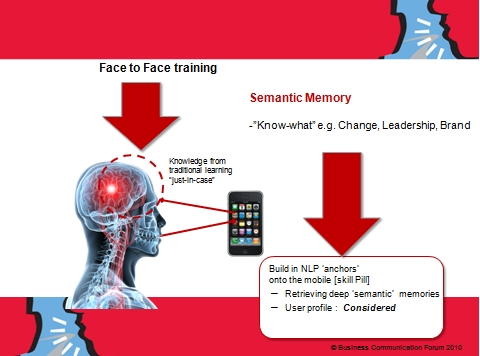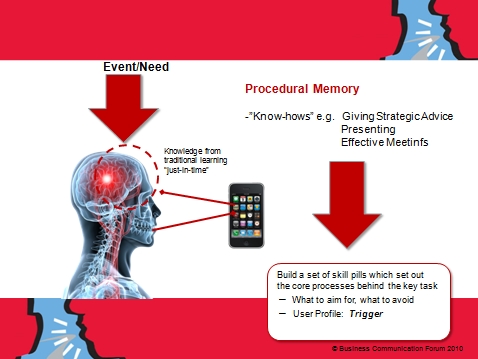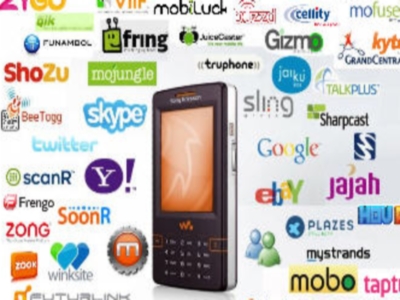Richard Castle looks at the fundamental success factors for mobile learning.
Until April 2010, the mobile learning market was at its tipping point. The recent launch of the Apple iPad has likely pushed this market into wide-scale acceptance and growth. Not surprisingly, the iPad has focused attention on the world of book publishing. But it is mobile learning that is perhaps better positioned to take advantage of the heightened awareness in homes and offices of what can be achieved on the move with the iPad and other mobile devices.
Even before the iPad, the mobile learning market was positioned for growth with plenty of content, applications, widgets and delivery platforms to run on mobile devices of all shapes and sizes.
Another sign of a burgeoning market is the wealth of market research available. Organisations such as Ambient Insight in the US predict great things for the market. Ambient’s report on the US market for mobile learning products and services (2008-13) highlighted eight key buying segments: consumer, corporations and business, federal government, state and local government, pre-12 academic, higher education, healthcare and non-profits and associations. Among the ten main markets for packaged content were professional training and development; business, sales and finance, handheld decision support; and medical, health, nutrition and fitness.
"The real impact of the mobile device and its learning content depends on the user; or to be more precise, the user’s task at hand and their frame of mind."
While we value mobile devices to help us communicate and access information and entertainment, the key to mobile learning is using a device to improve users’ productivity. We design content and delivery systems to improve the effectiveness of business information, instructions and learning as well as content to play across any mobile device giving the user just enough information, at just the right time, anywhere they choose to work.
The real impact of the mobile device and its learning content depends on the user; or to be more precise, the user’s task at hand and their frame of mind. Broadly speaking, there are two types of user for mobile learning – the considered and the trigger user.
The ‘considered’ and the ‘trigger’ user
The considered user will download and watch learning material on their regular commute for example, in the same way they would read a business book or listen to a motivational piece of content on their mobile device. They actively contemplate the material and adopt a reflective frame of mind in order to take a close look at their job.
The trigger user responds to contextual situations that require the user to take action. The number of trigger users seen in organisations has been increasing in recent years. They tend to be pressed for time. For example, they check and send emails as they walk down the corridor in between meetings. The mobile device is both the symptom as well as the potential cure for this type of user. Depending on the situation, users could be in a considered or trigger mode.
For the considered user, mobile learning retrieve information from their semantic memory i.e. our memories of ‘know-whats’. For example, within an organisation these include know-whats about change, branding, leadership or innovation. Mobile devices can retrieve these core principles and values, which are very important for the worker, but can be neglected without the right stimulus.

In this case mobile learning is best used as a refresher of face-to-face training. After a large chunk of training, your head is filled with information. A mobile devise is a smart way of retrieving what you have learnt, especially close to the time when you need to apply it. Using the principles of neuro-linguistic programming, key learning points can anchor mobile learning content to help the user efficiently and accurately recall these deep level semantic memories.
For trigger users the mobile device can act as a retriever for procedural memory. Procedural memory is used for skills or ‘know-how’. These are processes and techniques that are needed to drive business forward – what to do, what not to do, the attitudes and behaviours that are expected. Examples include simple skills such as running a creative meeting or how to induct an employee properly. They also include more complex skills such as managing

change and restructuring teams. From our experience with the use of Skill-Pills, mobile learning is also best focused around inflection points. These are times during the week where there is no opportunity to redo the task, where high-performance is vital. Examples of inflection points include issuing a verbal warning to an employee, conducting a meaty interview, and doing a key client review. These moments are the optimum times to be given new or refresher content. Our aim at Skill-Pill is to facilitate this, to enable people to make the most of those key inflection points.
"Leftbox"
This change in how we can use mobile devices to access training on the go is no different to the rapid way organisations have shifted from hard-drive computing to cloud computing. We no longer need all the applications loaded on our hard-drive. Instead we can use the mobile device to call down the content as and when we need it.
The mobile learning market has reached its tipping point with robust technology, services and delivery platforms. But the real driver to sustained growth is content. We need useful content available in accessible short bursts that are tailored to their purpose.
We at Skill-Pill are putting an extraordinary effort into making sure our content achieves this. Over four years, it has been fascinating to see the range of different rigours and skills required to change content from a range of formats, such as books or training sessions, into effective mobile learning content. We have taken training out of the classroom and onto the street. We have sliced it up into bite-sized chunks. We have made training less formal and allowed users to discover what they need to know.
Mobile learning won’t ever replace face-to-face training, but the technology and know-how exists to make it so much more effective.
Richard Castle of Skill-Pill M-Learning. Skill-Pill are releasing, in association with Pearson, a MobileMBA for iPads and iPhones at the end of this year.
Image found here.
Richard Castle looks at the fundamental success factors for mobile learning.
Until April 2010, the mobile learning market was at its tipping point. The recent launch of the Apple iPad has likely pushed this market into wide-scale acceptance and growth. Not surprisingly, the iPad has focused attention on the world of book publishing. But it is mobile learning that is perhaps better positioned to take advantage of the heightened awareness in homes and offices of what can be achieved on the move with the iPad and other mobile devices.
Even before the iPad, the mobile learning market was positioned for growth with plenty of content, applications, widgets and delivery platforms to run on mobile devices of all shapes and sizes.
Another sign of a burgeoning market is the wealth of market research available. Organisations such as Ambient Insight in the US predict great things for the market. Ambient’s report on the US market for mobile learning products and services (2008-13) highlighted eight key buying segments: consumer, corporations and business, federal government, state and local government, pre-12 academic, higher education, healthcare and non-profits and associations. Among the ten main markets for packaged content were professional training and development; business, sales and finance, handheld decision support; and medical, health, nutrition and fitness.
"The real impact of the mobile device and its learning content depends on the user; or to be more precise, the user’s task at hand and their frame of mind."
While we value mobile devices to help us communicate and access information and entertainment, the key to mobile learning is using a device to improve users’ productivity. We design content and delivery systems to improve the effectiveness of business information, instructions and learning as well as content to play across any mobile device giving the user just enough information, at just the right time, anywhere they choose to work.
The real impact of the mobile device and its learning content depends on the user; or to be more precise, the user’s task at hand and their frame of mind. Broadly speaking, there are two types of user for mobile learning – the considered and the trigger user.
The 'considered' and the 'trigger' user
The considered user will download and watch learning material on their regular commute for example, in the same way they would read a business book or listen to a motivational piece of content on their mobile device. They actively contemplate the material and adopt a reflective frame of mind in order to take a close look at their job.
The trigger user responds to contextual situations that require the user to take action. The number of trigger users seen in organisations has been increasing in recent years. They tend to be pressed for time. For example, they check and send emails as they walk down the corridor in between meetings. The mobile device is both the symptom as well as the potential cure for this type of user. Depending on the situation, users could be in a considered or trigger mode.
For the considered user, mobile learning retrieve information from their semantic memory i.e. our memories of ‘know-whats’. For example, within an organisation these include know-whats about change, branding, leadership or innovation. Mobile devices can retrieve these core principles and values, which are very important for the worker, but can be neglected without the right stimulus.

In this case mobile learning is best used as a refresher of face-to-face training. After a large chunk of training, your head is filled with information. A mobile devise is a smart way of retrieving what you have learnt, especially close to the time when you need to apply it. Using the principles of neuro-linguistic programming, key learning points can anchor mobile learning content to help the user efficiently and accurately recall these deep level semantic memories.
For trigger users the mobile device can act as a retriever for procedural memory. Procedural memory is used for skills or ‘know-how’. These are processes and techniques that are needed to drive business forward – what to do, what not to do, the attitudes and behaviours that are expected. Examples include simple skills such as running a creative meeting or how to induct an employee properly. They also include more complex skills such as managing

change and restructuring teams. From our experience with the use of Skill-Pills, mobile learning is also best focused around inflection points. These are times during the week where there is no opportunity to redo the task, where high-performance is vital. Examples of inflection points include issuing a verbal warning to an employee, conducting a meaty interview, and doing a key client review. These moments are the optimum times to be given new or refresher content. Our aim at Skill-Pill is to facilitate this, to enable people to make the most of those key inflection points.
"Leftbox"
This change in how we can use mobile devices to access training on the go is no different to the rapid way organisations have shifted from hard-drive computing to cloud computing. We no longer need all the applications loaded on our hard-drive. Instead we can use the mobile device to call down the content as and when we need it.
The mobile learning market has reached its tipping point with robust technology, services and delivery platforms. But the real driver to sustained growth is content. We need useful content available in accessible short bursts that are tailored to their purpose.
We at Skill-Pill are putting an extraordinary effort into making sure our content achieves this. Over four years, it has been fascinating to see the range of different rigours and skills required to change content from a range of formats, such as books or training sessions, into effective mobile learning content. We have taken training out of the classroom and onto the street. We have sliced it up into bite-sized chunks. We have made training less formal and allowed users to discover what they need to know.
Mobile learning won’t ever replace face-to-face training, but the technology and know-how exists to make it so much more effective.
Richard Castle of Skill-Pill M-Learning. Skill-Pill are releasing, in association with Pearson, a MobileMBA for iPads and iPhones at the end of this year.
Image found here.










